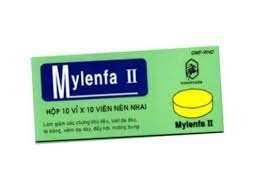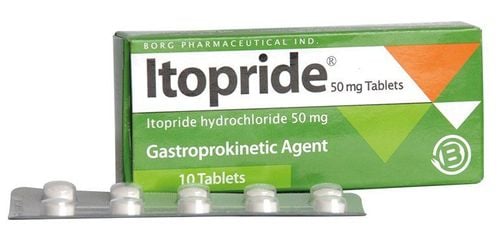This is an automatically translated article.
Ranitidine drug is used in the treatment of diseases such as duodenal ulcer - benign stomach, reflux oesophagitis, Zollinger - Ellison syndrome. The drug is present at most drugstores nationwide in the form of tablets/capsules Ranitidine 300mg, 150mg, 75mg, 25mg,...
1. What is Ranitidine?
Ranitidine belongs to the group of gastrointestinal drugs, antacids, anti-reflux and ulcers. The drug has the main ingredient is Ranitidine (in the form of Ranitidine hydrochloride) with the content of 50mg / 2ml, prepared in the form of an injectable solution packed in boxes of 5 ampoules, boxes of 10 ampoules, boxes of 20 ampoules x 2ml.
Ranitidine drug is used in the treatment of gastric reflux, indigestion, peptic ulcer. Ranitidine is manufactured at Vinh Phuc Pharmaceutical Joint Stock Company.
Ranitidine 50mg is a drug that is only used by prescription of doctors and pharmacists and is used for subjects from 6 months of age and older.
2. Indications for use of Ranitidine
Ranitidine is indicated for use in the following cases:
Duodenal ulcer - benign stomach. Chronic intermittent gastrointestinal disorders. Reflux esophagitis. Zollinger-Ellison syndrome. Postoperative ulcers Prevention of gastrointestinal bleeding, stress ulcers in critically ill patients; Prevention of recurrent bleeding in patients with peptic ulcer disease and prophylaxis before general anesthesia in patients at risk of acid aspiration, typically in pregnant women in labor. Treatment of symptoms of indigestion.
3. How to use Ranitidine effectively
Usage:
Ranitidine is usually used orally, in addition, it can be used for intramuscular injection or intravenous / intravenous infusion. Dosage of Ranitidine:
Oral: Use 150mg / time and use it 2 times a day in the morning and evening or can use a single dose of 300mg in the evening. Patients with benign gastric ulcer and duodenal ulcer take Ranitidine from 4 to 8 weeks; with patients with chronic gastritis taking Ranitidine Up to 6 weeks; For patients with ulcers caused by non-steroidal anti-inflammatory drugs, take Ranitidine for 8 weeks; For patients with duodenal ulcer, the drug can be taken for 4 weeks at a dose of 300mg and taken twice a day. Children: treatment of peptic ulcers, dose 2-4 mg Ranitidine/kg body weight, orally 2 times/day, maximum oral dose of 300mg Ranitidine/day. The maintenance dose is 150 mg of Ranitidine/day, taken at night. Prevention of peptic ulcers caused by non-steroidal anti-inflammatory drugs: Take 150mg of Ranitidine, twice a day. Treatment of gastroesophageal reflux, esophagitis: Take 150mg of Ranitidine, 2 times a day or 300mg of Ranitidine 1 time at night, the duration of treatment lasts from 8 to 12 weeks. When the disease is controlled, the long-term dose of ranitidine 150mg twice daily can be maintained. Treatment of Zollinger - Ellison syndrome: Take 150mg of Ranitidine, 3 times a day. Maximum dose up to 6g / day, divided into several times. To reduce stomach acid in obstetrics: Use 150mg of Ranitidine at the time of labor, then every 6 hours; In surgery: intramuscular or slow intravenous injection 1 dose of ranitidine 50mg, 45-60 minutes before anesthesia or 150mg dose of ranitidine 2 hours before anesthesia and if possible, 150mg ranitidine the night before. Intramuscular injection: Inject 50 mg of Ranitidine every 6-8 hours. Slow intravenous injection: Inject 50 mg of Ranitidine, dissolve into 20 ml of solution, inject slowly over a minimum of 2 minutes, repeated every 6 to 8 hours. Intravenous infusion: Dose of 25mg Ranitidine/hour, infused over 2 hours; every 6 - 8 hours, repeat infusions are possible. Prophylaxis of bleeding in peptic ulcers due to stress in critically ill patients: First slow intravenous injection of 50mg of Ranitidine as above, then continuous infusion of 125-250 micrograms/kg/hour. After that can be given twice a day, each time 150mg Ranitidine when the patient has eaten.
4. What to do when overdose, forget dose?
Ranitidine drug is quite well absorbed and is almost not too dangerous in overdose. Currently, there is no specific antidote for Ranitidine poisoning. In case of overdose, supportive treatment and symptoms are as follows:
Convulsions: Use diazepam. Bradycardia: Inject atropine. Ventricular arrhythmias: Inject lidocaine. Patients need to be monitored and controlled for unwanted side effects. If necessary, hemodialysis will be used to remove the drug from the plasma.
Medicines are only used when needed and according to the dosing schedule prescribed by the doctor, so missed doses almost do not happen.
5. Contraindications to taking Ranitidine?
Do not use for patients with hypersensitivity to Ranitidine or to any of the active ingredients in the drug.
6. Side effects when using Ranitidine drug treatment
During the use of Ranitidine, patients may experience some unwanted side effects such as:
Acute pancreatitis. Joint pain, muscle pain. Hypersensitivity, confusion. Body as a whole: Weakness, headache, dizziness. Digestion: Diarrhea. Skin: Erythema, skin rash, itching, pain at injection site, Erythema multiforme Decrease in white blood cells, blood cells and platelets; agranulocytosis. Liver: Increased transaminases, reversible hepatitis sometimes with jaundice. Hypersensitivity reactions such as bronchospasm, urticaria, anaphylactic shock, arthralgia, angioedema, myalgia. Cardiovascular: Hypotension, bradycardia, atrioventricular block, systolic failure after rapid injection. Endocrine: Enlarged breasts in men. Eyes: Disorders of eye accommodation. When experiencing side effects of Ranitidine, the patient should stop using and notify the doctor or go to the nearest medical center for timely treatment.
7. Precautions when using Ranitidine
Before using Ranitidine, patients should carefully refer to the instructions for use of the drug or order from a doctor or pharmacist. In addition, you can refer to some more cautions when using therapeutic drugs as follows:
Caution should be used when using Ranitidine in patients with severe liver failure, acute porphyria, because there is an increased risk of side effects. desired when taking the drug. People with heart disease are at risk of bradycardia if taking Ranitidine. Treatment with ranitidine may mask the symptoms of stomach cancer and delay its diagnosis. Therefore, before taking the drug, the patient should be excluded the possibility of cancer before treatment. Ranitidine should be used with caution in patients with renal impairment, as there are data on the renal excretion of Ranitidine. Therefore, to avoid elevated plasma concentrations, a minimum dose of 25 mg should be used in the evenings and maintained for 4 to 8 weeks. Ranitidine should not be used in patients with a history of porphyria. Ranitidine 50mg may cause headache and dizziness. Therefore, do not use the drug when experiencing any unwanted effects of the drug, especially while driving and operating machinery. Ranitidine is secreted across the placenta, but in practice, therapeutic doses have not been shown to cause harm to the fetus or the delivery process. However, caution should still be exercised when using Ranitidine in pregnant women. There have been reports that Ranitidine is excreted in breast milk, so it is not recommended to use the drug while breastfeeding, only use when necessary and prescribed by a doctor.
8. Ranitidine drug interactions
Ranitidine when used with some of the following drugs can cause interactions such as:
Ranitidine used with Glipizide can lower blood sugar or Cimetidine also causes low blood sugar but it doesn't seem to be much. Ranitidine combined with anticoagulants such as Propranolol, Cumarin, Diazepam, Theophylline causes very little inhibition of metabolism in the liver. The affinity of Ranitidine for cytochrome P450 enzymes is about 10% compared with Cimetidine and the degree of inhibition of liver enzymes is 2-4 times less than cimetidine. When quinolones are used in combination with ranitidine, most of these antibiotics are not affected, but enoxacin has reduced bioavailability when co-administered with ranitidine, but is not clinically important. When using Fluconazole, Ketoconazole and Itraconazole with Ranitidine, these drugs are reduced absorption because Ranitidine reduces acidity in the stomach. When Theophylline is used in combination with Ranitidine, the serum concentration of Theophyllin and toxicity are minimal. Co-administration of ranitidine with clarithromycin increases the plasma concentration of ranitidine by approximately 57%. Concomitant administration of propanthelin bromide increases peak serum concentrations of ranitidine and slows absorption, possibly due to delayed gastric transit. Concomitant administration of ranitidine with food or with a low dose of antacids did not result in decreased absorption or peak plasma concentrations of ranitidine. Above is some information to share about the uses, dosage and notes when using Ranitidine. To ensure safety for your health and maximize the effectiveness of your treatment, you need to take Ranitidine exactly as directed by your doctor.
Please dial HOTLINE for more information or register for an appointment HERE. Download MyVinmec app to make appointments faster and to manage your bookings easily.













